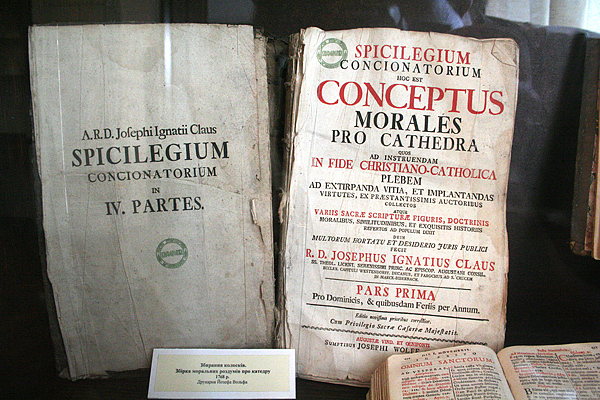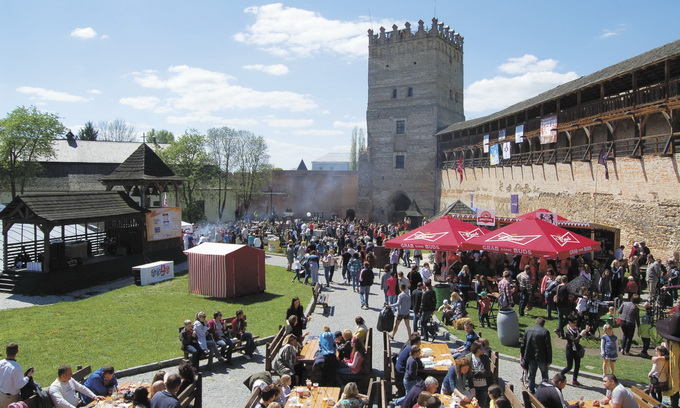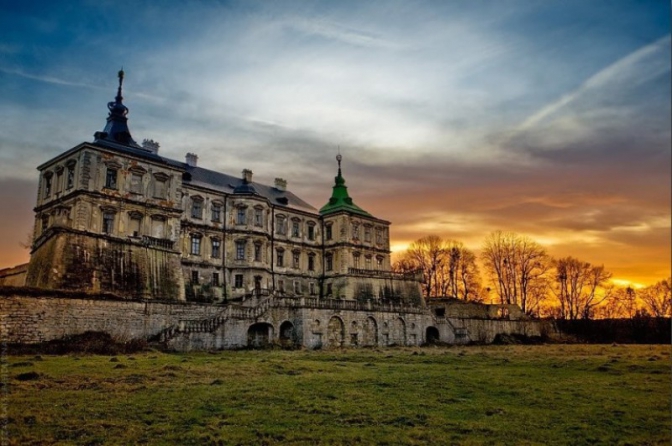Scattered across the country, such places can make reality blur, erasing the hazy lines between eras. Recalling the turbulent times of principalities, kingdoms and empires that no longer exist, these castles are filled with magic and mystery. But they have a dark side too, where spirits and superstitions may yet linger.
Chynadiyovo Castle
The Saint Miklós (Saint Nicholas) Castle in Chynadiyovo, Mukachevo raion, Zakarpattia Oblast, has a lasting legacy — its palisades dared to challenge fate and survived against all odds. Lost among the majesty of the Zakarpattia mountains, it is in one of the most mesmerizing corners of Ukraine.
Yet, for decades the castle stood in disrepair. The Soviets used it for industrial storage and landfill. It had reached a critical condition when its savior came along. Jossyp Bartosz, a painter and musician, discovered Saint Miklos Castle and decided to lease it and bring back its glory.
“This castle chose me. It just said: ‘Here! Come here!’ and I came,” Bartosz exclaims in his interview for culture magazine Ukrainer.
Having lived abroad for years, Bartosz returned to Ukraine in 1999. During his travels, he found himself inspired by the restored castles of neighboring Poland, Slovakia, Romania and Hungary. He decided to organize open-air exhibitions, such as he had experienced abroad, in the Chynadiyovo Castle.
No one believed in his idea — some even called it madness. However, Bartosz prevailed. He ignored the mockery of local residents and was relentless in procuring the necessary financing. Finally, he won the fight and began the monumental task of clearing out debris and launching the restoration project.
The history of Chynadiyovo goes back to the 14th century when it was built by order of Baron Perényi. It was strategically positioned in the Veretsky Pass — a mountain pass that led directly to Halychyna and was used by Hungarian kings to attack surrounding regions.
Since then, Chynadiyovo has had many owners and seen many colorful episodes. One such is the desperate love story of two Hungarian rebels, Ilona Zrínyi and Imre Thököly, who fought together against the absolute power of the Austro-Hungarian Empire in the 17th century. Their brutal demise seems to reverberate in the castle corridors to this day.
However, things have changed and Chynadiyovo Castle is bustling with activity. Open-air gatherings, festivals, exhibitions, concerts, and theatre performances can all be attended throughout the year. The castle is even available for weddings and special ceremonies, many of which draw upon the traditions of the medieval royal courts.
Lubart’s Castle
Lubart’s Castle, also known as High Castle and Lutsk Castle, is one of the biggest and oldest fortifications in Ukraine, and it has been preserved close to its original form. Built in the 14th century in the city of Lutsk by Lithuanian Prince Vitovt Lubart, it served as a residence and fortress.
Now, tourists can climb the steep staircase of the castle’s entry tower and enjoy the view of the city. Old Lutsk, including monuments of the state historical and cultural reserve, are also visible.
In the summer, Lubart’s Castle hosts a number of events ranging from medieval tournaments to modern music concerts and food festivals.
Pidhirtsi Castle
Built in the middle of the 17th century, Pidhirtsi Castle is a precious pearl of the Lviv region. This architectural monument is a true example of a Renaissance palace, with its spectacular bastions. The three-story castle boasts grounds encompassing a luxurious park, a courtyard and an ornate cathedral — all of which were added during the 18th century and reflect the Baroque style.
The castle was a wondrous combination of elegance and fortification, with refined terraces contrasted by imposing ramparts. In its day, it was considered to be one of the most beautiful castles in Europe. Although it was well fortified by massive bulwarks and a deep moat, enemies still dared to launch attacks.
Yet, each time it was rebuilt throughout the centuries, the palace assumed greater beauty and its defenses became even more impenetrable.
The park of the castle complex is truly a masterpiece of architectural landscaping, and is the only Ukrainian park created in the Baroque Italian style. Very likely, the park was meant to impress guests even more than the palace.
Palanok Castle
The history of this castle is also connected to Hungarian countess Ilona Zrínyi, the implacable fighter against the Austro-Hungarian imperialist regime. In Hungary, she is considered a national hero. Her forces held the castle, while under fierce siege, for three long years. Her defenses were aided by the castle’s strategic location and construction.
Palanok Castle was built on top of an extinct volcano with an astounding height of 68 meters. It was built with three terraces — the upper, middle and lower locks — serving to provide even more protection.
Today, its very walls seem to echo gloomy legends, steeped in mysterious tales and untold secrets.
Kamianets-Podilskyi Castle
In the Middle Ages, Kamianets-Podilskyi Castle was considered an impregnable fortress. According to legend, in 1621 the army of the Turkish Osman Sultan was constantly repelled by the strength of its walls and towers. Mystified, he exclaimed, “Who created this stone miracle?” The answer came from his solders, “It was Allah.” The sultan is said to have retorted, “So let Allah conquer it,” and gave the order to retreat.
Since that era, the castle has been destroyed and rebuilt numerous times. Today, Kamianets-Podilskyi Castle is a museum of history, and is included in the list of the “Seven Wonders of Ukraine.”
Read also: The seven wonders of Ukraine
Music video by B&B featuring the cover of the Game of Thrones theme, filmed in Kamianets-Podilskyi Castle.
The ancient city of Kamianets-Podilskyi, for which this castle was named, has remained suspended in the 13th century. It celebrates its medieval legacy every year with themed festivals that attract tourists from near and far.
https://www.youtube.com/watch?v=M1RV19yjJeE
The terrain of the Kamianets-Podilskyi Сastle is divided into two segments. The first is the Old Castle, which is the main attraction of the city, and the second is the New Castle, with its impressive bastions of fortification. The castle is widely renowned as a UNESCO world heritage site.
Read also:
- The mystery of how Kyivan Rus shaped early Christianity in Norway
- Win for history in Ukraine: Kyivan Rus archeology site to become museum, not shopping mall
- A glimpse of 1905 Ukraine in true color
- Before and after: metamorphoses of Soviet architecture
- The three Ukrainian women breathing new life into ancient musical traditions
- Explore Ukrainian traditional culture with interactive site “Authentic Ukraine”
- Forgotten history: What tour guides at Kyiv-Pechersk Lavra aren’t saying…
- Khrushchovka apartments: the French dream that became a Soviet reality
- Russia methodically destroys and removes cultural treasures from occupied Crimea
- Watercolors of wooden churches destroyed in Operation Vistula to be published as…
- Lychakiv Cemetery, Lviv: an open-air museum of history, culture, art and remembrance
- Modernized past: how today’s Ukrainian culture combines tradition and modernity
- Ukrainian experts hope UNESCO status will help preserve ancient Trypillian culture
- Donbas culture: understanding it and avoiding mistakes in the future
- Russia putting historic Crimean landmarks in danger
- Ukrainian neck ornaments: history and symbols
- Ukrainian history gift to global history – Prof. Snyder
- How Moscow hijacked the history of Kyivan Rus’
- Rare postcards depict Ukrainian village life at turn of 20th century
- Anna of Kyiv, the French Queen from Kyivan Rus
- Remnants of a 12th century unique medieval fortification wall discovered in Kyiv
- 900-year-old relic found under church floor in Busk, Lviv Oblast

































































